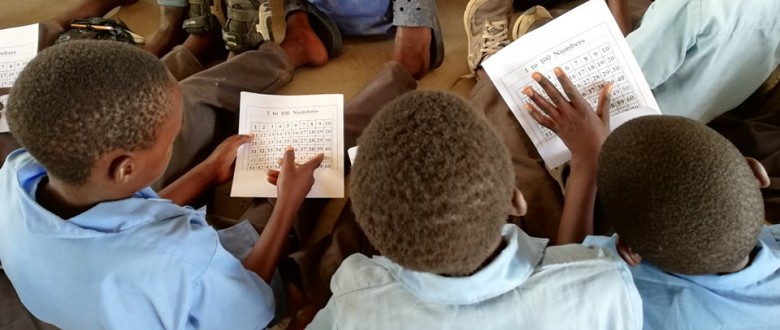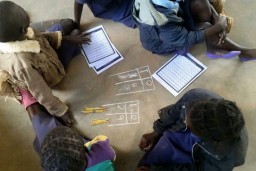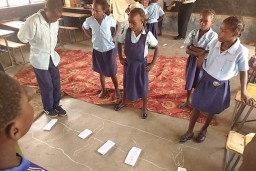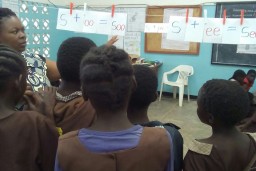
The World Bank estimates that at least 53% of all children in low- and middle-income countries are not able to read proficiently by the age of 10. In Sub-Saharan Africa, learning poverty is close to 87%. Learners who fall behind in primary education need access to effective recourse programmes to catch up. With the Teaching at the Right Level (TaRL) methodology, the Zambian Ministry of Education and its partners have shown how we could approach this. Learners’ abilities to read a simple paragraph or do a simple subtraction increased with 21 and 24 percentage points respectively after six months of TaRL.
Teaching at the right level
Picture this: as a child, you attend school every day, but still cannot read, write or calculate. However hard to fathom for some, this is the sobering reality for millions of learners in Sub-Saharan Africa and beyond. In Zambia, for instance, a mere 35 percent of students in grades 3 to 5 in the country’s Eastern and Southern provinces was able to read a simple paragraph at the beginning of 2019. Less than one third of pupils could do two-digit subtraction.
Learners who fail to develop these foundational skills in the early grades have a right to effective recourse against more learning challenges in later life. The Catch Up project in Zambia provides them with this much-needed opportunity to… catch up, showing spectacular progress among learners. By ‘teaching at the right level’ – i.e. grouping learners by ability rather than age – the percentage of those learners in grades 3 to 5 that is able to read a simple paragraph and solve a simple math problem rose from 35 to over 50 percent by the end of the second term of 2019.
Enrolment ≠ learning
Worldwide, significant strides have been made towards increasing access to basic education, steered to a large extent by Millennium Development Goal 2. Today, enrolment rates around the globe are nearing, reaching or even trespassing the 100 percent mark.
While indeed good news, enrolment does not guarantee learning, as various reports and learning assessments show. Millions of learners, particularly in Sub-Saharan Africa, lack basic literacy and numeracy skills, with socio-economically disadvantaged children learning the least. In Zambia, 64 percent of grade 2 pupils cannot read a single word of a short text in their own local language (USAID, 2019). Numeracy results are equally sobering.
The World Bank has called for action to curb the ‘Learning Crisis’ with reason. In particular, they want to address ‘learning poverty’ – the share of children unable to read and understand a simple text by age 10. After all, if children cannot read, they cannot learn in other subjects either.
Catch Up to the rescue
Despite the surge in enrolment rates, many interventions continue to focus on enrolment, without paying attention to the quality of learning. And, the interventions that do target learning, usually focus on the early grades. As a result, there is no recourse for children in the upper grades who failed to develop basic literacy and numeracy skills in the earlier grades. Programmes like Catch Up close that gap.
Catch Up is a form of remedial teaching that targets learners in primary grades 3 to 5, using the ‘Teaching at the Right Level’ (TaRL) methodology. Developed by the Indian NGO Pratham, TaRL groups learners by ability, rather than age or level, and makes use of interactive teaching methodologies, combining groupwork, play and individual exercises.
In 2016/2017, a partnership composed of the Zambian Ministry of General Education (MoGE), UNICEF, the Abdul Latif Jameel Poverty Action Lab (J-PAL), Innovations for Poverty Action (IPA) Zambia, the University of Cape Town and VVOB introduced TaRL in Zambia with the support of USAID – pointedly nicknaming the intervention Catch-Up. Up from merely 80 schools in the pilot year, close to 1,800 schools will have provided all grade 3 to 5 learners with daily 1-hour TaRL sessions by August 2020.
Stunning progress
A key element, Catch Up teachers regularly assess learners using two simple, one-on-one tools – one for literacy and one for numeracy – that classify children into five groups (see table below). These learner assessments serve two purposes. First, they enable learners to progress to other groups at their own pace. Second, the assessments – when aggregated – inform MoGE and its partners about the progress made at district and provincial level, while also pinpointing those areas in need of more support. And progress has been remarkable! Between January and July of 2019, the share of students able to read a simple paragraph and able to do subtraction increased with 21 and 24 percentage points respectively (Catch Up 2019 endline data).
| Literacy | Numeracy | |
| 1 | Beginner (cannot recognise letters) |
Beginner |
| 2 | Letter recognition | One-digit number recognition |
| 3 | Word recognition | Two-digit number recognition |
| 4 | Paragraph reading | Subtraction and addition |
| 5 | Story reading | Division and multiplication |
Catch Up is received with great enthusiasm. “What I like most [about Catch Up] is the involvement of the learners”, one MoGE official shared. “Teachers”, another official explained, “have embraced Catch Up more than any other programme”. Not surprisingly then, MoGE is keen to further scale up Catch Up and reach all learners in grade 3 to 5 in the country. VVOB is keen too!
TaRL proof of concept by Nobel Laureates in Economics!
At the origins of Teaching at the Right Level (TaRL) was Pratham’s Balsakhi programme. Female community volunteers, called Balsakhi’s, provided two hours of catch up classes per day to grade 3 and 4 learners with learning arrears. Seemingly successful, Pratham decided to partner with the Abdul Latif Jameel Poverty Action Lab (J-PAL), a research centre connected to the Massachusetts Institute of Technology, to obtain proof of concept. Over the course of 2001-2004, various randomised controlled trials were set up, demonstrating significant increases in foundational skills. Since then, J-PAL and its sister organisation Innovations for Poverty Action (IPA) have remained closely involved in researching and evaluating TaRL, including in Zambia. This year, J-PAL and Pratham formalised their partnership in Africa through the establishment of Teaching at the Right Level Africa.
This year, the co-founders of J-PAL Abhijit Banerjee and Esther Duflo, won the Nobel Prize in Economics together with their colleague Michael Kremer for their experimental approach to alleviating global poverty. VVOB is very proud to be collaborating with them and all other J-PAL and IPA researchers in Zambia and beyond.










